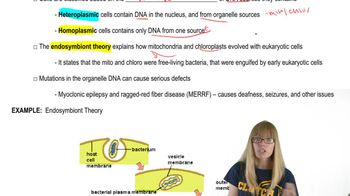Table of contents
- 1. Introduction to Genetics51m
- 2. Mendel's Laws of Inheritance3h 37m
- 3. Extensions to Mendelian Inheritance2h 41m
- 4. Genetic Mapping and Linkage2h 28m
- 5. Genetics of Bacteria and Viruses1h 21m
- 6. Chromosomal Variation1h 48m
- 7. DNA and Chromosome Structure56m
- 8. DNA Replication1h 10m
- 9. Mitosis and Meiosis1h 34m
- 10. Transcription1h 0m
- 11. Translation58m
- 12. Gene Regulation in Prokaryotes1h 19m
- 13. Gene Regulation in Eukaryotes44m
- 14. Genetic Control of Development44m
- 15. Genomes and Genomics1h 50m
- 16. Transposable Elements47m
- 17. Mutation, Repair, and Recombination1h 6m
- 18. Molecular Genetic Tools19m
- 19. Cancer Genetics29m
- 20. Quantitative Genetics1h 26m
- 21. Population Genetics50m
- 22. Evolutionary Genetics29m
10. Transcription
Transcription in Eukaryotes
Problem 25d
Textbook Question
Elysia chlorotica is a sea slug that acquires chloroplasts by consuming an algal food source, Vaucheria litorea. The ingested chloroplasts are sequestered in the sea slug's digestive epithelium, where they actively photosynthesize for months after ingestion. In the algae, the algal nuclear genome encodes more than 90% but not all of the proteins required for chloroplast metabolism. Thus it is suspected that the sea slug actively maintains ingested chloroplasts, supplying them with photosynthetic proteins encoded in the sea slug genome. How would you determine whether the sea slug has acquired photosynthetic genes by horizontal gene transfer from its algal food source? Discuss the steps required for heritable endosymbiosis to eventuate, and their plausibility.
 Verified step by step guidance
Verified step by step guidance1
Step 1: Identify and sequence the genes involved in photosynthesis in both the sea slug (Elysia chlorotica) and the algal food source (Vaucheria litorea). This involves extracting DNA from both organisms and using sequencing technologies to determine the genetic sequences.
Step 2: Compare the genetic sequences of the photosynthetic genes from the sea slug and the algae. Look for similarities that suggest horizontal gene transfer, such as identical or highly similar sequences that are unlikely to have arisen independently.
Step 3: Investigate the expression of these photosynthetic genes in the sea slug. Use techniques like RT-PCR or RNA sequencing to determine if these genes are actively transcribed in the sea slug, indicating functional integration.
Step 4: Examine the localization of the proteins encoded by these genes in the sea slug. Use protein tagging and microscopy to see if the proteins are targeted to the chloroplasts, supporting the idea that they are functional and contribute to photosynthesis.
Step 5: Consider the evolutionary implications and plausibility of heritable endosymbiosis. Evaluate whether the integration of these genes into the sea slug's genome is stable and heritable, and discuss the evolutionary advantages and challenges of such a symbiotic relationship.
Recommended similar problem, with video answer:
 Verified Solution
Verified SolutionThis video solution was recommended by our tutors as helpful for the problem above
Video duration:
3mPlay a video:
Was this helpful?
Key Concepts
Here are the essential concepts you must grasp in order to answer the question correctly.
Horizontal Gene Transfer (HGT)
Horizontal Gene Transfer refers to the process by which an organism incorporates genetic material from another organism without being its offspring. This can occur through various mechanisms, such as transformation, transduction, or conjugation. In the context of Elysia chlorotica, HGT would involve the transfer of photosynthetic genes from the algal food source to the sea slug, enabling it to maintain and utilize the chloroplasts it ingests.
Recommended video:
Guided course

Mapping Genes
Endosymbiotic Theory
The Endosymbiotic Theory posits that certain organelles, like chloroplasts and mitochondria, originated from free-living prokaryotes that were engulfed by ancestral eukaryotic cells. Over time, these engulfed organisms became integral to the host cell's metabolism. For Elysia chlorotica, understanding this theory helps explain how the sea slug might maintain functional chloroplasts and the potential for gene transfer to occur during this symbiotic relationship.
Recommended video:
Guided course

Organelle DNA Characteristics
Gene Expression and Regulation
Gene Expression and Regulation involve the processes by which information from a gene is used to synthesize functional gene products, typically proteins. In Elysia chlorotica, the ability to express algal genes after ingestion would be crucial for maintaining chloroplast function. Investigating whether the sea slug can express these genes, possibly through regulatory mechanisms that allow for the integration of foreign DNA, is essential for understanding the implications of HGT in this context.
Recommended video:
Guided course

Penetrance and Expressivity

 9:16m
9:16mWatch next
Master Eukaryotic Transcription with a bite sized video explanation from Kylia Goodner
Start learningRelated Videos
Related Practice


